MS Excel 2007 - Lesson 3: Working with Workbook
How to create a Workbook in Excel 2007? In this article, TipsMake.com will guide you through the detailed steps to create Workbook in Excel 2007.
Work with Workbook
- Create a Workbook
- Save a Workbook
- Open a Workbook
- Insert information
- Cell address (Cell address)
- Edit or delete text
- Move back and forth in a page using the keyboard
- Compatibility mode (Compatibility mode)
- Exit Compatibility mode
- Practice!
Create a Workbook
• Click the Microsoft Office Toolbar
• Click New
• Select Blank Document

If you want to create a new document from an existing template, see the available templates and choose one of the styles you need.
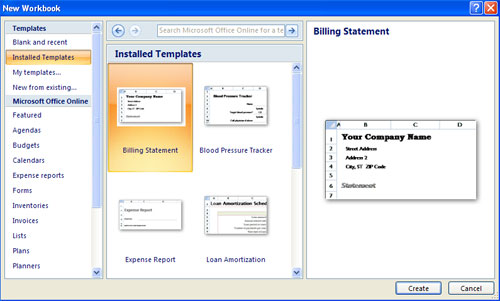
Save a Workbook
When you save a workbook, you have two options: Save or Save As .
To save a document:
• Click Microsoft Office Button
• Click Save or Save As

You can use the Save As feature when you need to save a workbook as another name or save it as previous versions of Excel. Remember that older versions of Excel may not be able to open a worksheet in Excel 2007 until you save it as Excel 97-2003 format. To use the Save As feature:
• Click Microsoft Office Button
• Click Save As
• Enter a name for the Workbook
• In the Save as Type box, select Excel 97-2003 Workbook.
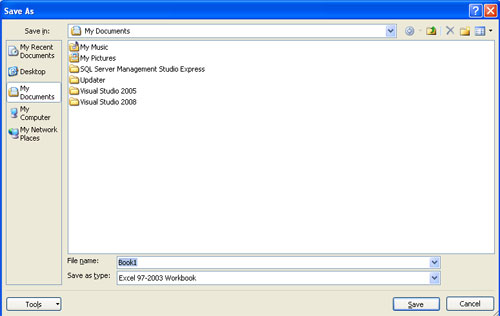
Open a Workbook
To open an existing workbook:
• Click Microsoft Office Button
• Click Open
• Browse through the workbooks
• Select the workbook you need to open
• Click Open
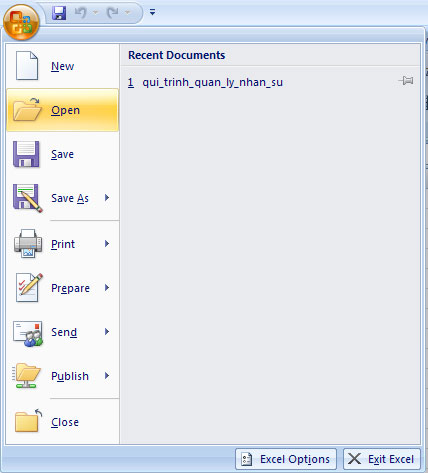
Insert information
There are many different ways to import data in Excel: in a cell or in the formula bar.
To enter data into a cell:
• Click the box where you want to enter data
• Start typing content
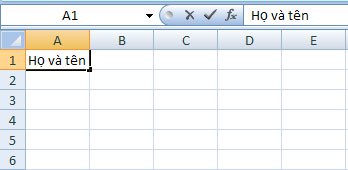
To enter data into the toolbar:
• Click the box where you want to enter data
• Place the cursor on the formula bar
• Insert information
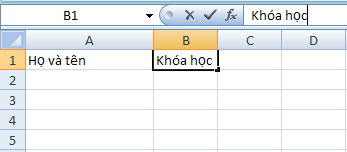
Cell address (Cell address)
Each cell has a name or a cell address, based on the column and row where it is located. For example, the cell in the following example is C3 because it is where column C and row 3 intersect.
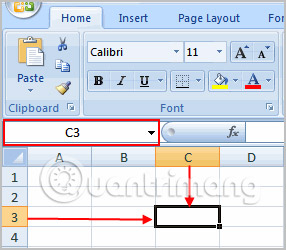
You can also select multiple cells at once. A group of cells is called a cell range. Instead of a single cell address, you will refer to a range by using the cell address of the first cell and the last cell in the range, separated by a colon. For example, a cell range that includes cells A1, A2, A3, A4, and A5 will be written as A1: A5.
If the columns in your spreadsheet are labeled with numbers instead of letters, you'll need to change the default reference type for Excel.
Edit or delete text
- Select the box.
- Press the Backspace key on the keyboard to delete text or edit the text content.
- Press the Delete key to delete the entire contents of a cell.
You can also make changes and delete text from the formula bar. Just select the box, then place your cursor in the formula bar.
Move back and forth in a page using the keyboard
- Press the Tab key to move to the right of the selected cell.
- Press the Shift key with the Tab key to move to the left of the selected cell.
- Use the Page Up and Page Down keys to navigate the sheet.
- Use the arrow keys.
Compatibility mode (Compatibility mode)
Sometimes you may need to work with workbooks that were created in earlier versions of Microsoft Excel, such as Excel 2003 or Excel 2000. When you open these workbooks, they will appear in Compatibility mode (mode). compatibility).
Compatibility mode will turn off certain features, so you will only be able to access the commands found in the program used to create the workbook. For example, if you open the workbook created in Excel 2003, you can only use the tabs and commands found in Excel 2003.

If you want to access all the features of Excel 2007, you can save the workbook in Excel 2007 file format.
Exit Compatibility mode
- Click the Microsoft Office button .
- Select Save As> Excel Workbook .
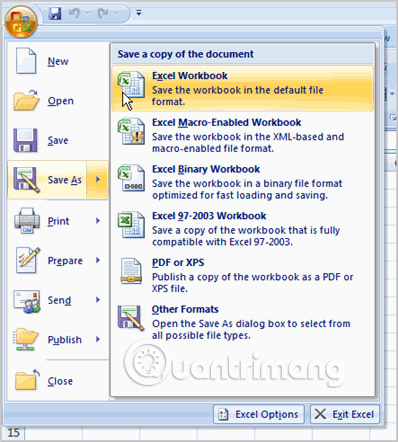
Practice!
- Open Excel.
- Create a new blank workbook.
- Practice entering text into cells.
- Practice deleting text with Backspace and Delete keys .
- Navigate sheets by using the Tab key .
- Save spreadsheet.
Next lesson: MS Excel - Lesson 4: Working with data
Previous lesson: MS Excel 2007 - Lesson 2: Customizing in Excel
You should read it
- MS Excel 2007 - Lesson 2: Customizing in Excel
- MS Excel 2007 - Lesson 6: Calculation in Excel
- Microsoft Excel Test P11
- MS Excel 2007 - Lesson 12: Develop Workbook
- MS Excel 2007 - Lesson 9: Insert images and graphics into a spreadsheet
- MS Excel 2007 - Lesson 5: Edit Worksheet
- MS Excel 2007 - Lesson 8: Sort and Filter
- New points in Microsoft Office Excel 2007
May be interested
- MS Excel 2007 - Lesson 7: Create Macros in Excel 2007
 macros are advanced features, which can speed up editing or formatting that you can do regularly in an excel spreadsheet. in this excel lesson, tipsmake.com will show you how to use macros in excel 2007.
macros are advanced features, which can speed up editing or formatting that you can do regularly in an excel spreadsheet. in this excel lesson, tipsmake.com will show you how to use macros in excel 2007. - MS Excel - Lesson 4: Working with lines, columns, sheets
 in addition to the content of tables in excel, operations with lines, columns and sheets in this program are also important. in this article, tipsmake.com will guide you to simple operation to add or remove lines, columns or sheets in excel tables.
in addition to the content of tables in excel, operations with lines, columns and sheets in this program are also important. in this article, tipsmake.com will guide you to simple operation to add or remove lines, columns or sheets in excel tables. - How to use themes in Excel
 the excel theme is a collection of colors, fonts and effects you can use for your workbook, ensuring your excel appearance is consistent and professional.
the excel theme is a collection of colors, fonts and effects you can use for your workbook, ensuring your excel appearance is consistent and professional. - MS Excel - Lesson 7: Sample Excel file - How to create and use
 when working with spreadsheets, sometimes you want to use the same layout or design. you can re-create the design every time to use it or you can create a template yourself.
when working with spreadsheets, sometimes you want to use the same layout or design. you can re-create the design every time to use it or you can create a template yourself. - MS Excel 2007 - Lesson 10: Modify columns, rows and cells
 when you open a new blank workbook in excel 2007, cells, columns, and rows are set to default sizes. you can change the size of each cell, column and row, as well as insert new columns, rows and cells if needed.
when you open a new blank workbook in excel 2007, cells, columns, and rows are set to default sizes. you can change the size of each cell, column and row, as well as insert new columns, rows and cells if needed. - MS Excel 2007 - Lesson 1: Start Microsoft Excel 2007
 starting with excel 2007, you should note that there are many similar features to previous versions. and there are many new features that you can use. there are 3 features you should remember when working in excel 2007: microsoft office button, quick access toolbar, and ribbon.
starting with excel 2007, you should note that there are many similar features to previous versions. and there are many new features that you can use. there are 3 features you should remember when working in excel 2007: microsoft office button, quick access toolbar, and ribbon. - MS Excel 2007 - Lesson 2: Customizing in Excel
 excel 2007 provides a wide range of customizable options, allowing you to work with excel in the most convenient way.
excel 2007 provides a wide range of customizable options, allowing you to work with excel in the most convenient way. - MS Excel - Lesson 14: Install and remove free Excel Add-ins
 excel add-in is an extension in excel programs. when installing, it is a small application, it will add a function so that excel can easily perform complex operations.
excel add-in is an extension in excel programs. when installing, it is a small application, it will add a function so that excel can easily perform complex operations. - 6 ways to fix arrow keys not working in Excel
 the arrow keys help you move from cell to cell in an excel spreadsheet with a single keystroke. it can be frustrating when your excel arrow keys aren't working properly.
the arrow keys help you move from cell to cell in an excel spreadsheet with a single keystroke. it can be frustrating when your excel arrow keys aren't working properly. - Instructions on how to automatically open a Workbook when you open Excel
 if you are an office worker, your daily work requires regular use of excel. suppose in the case if you often use a spreadsheet. instead of spending every day opening excel and opening the excel spreadsheet, you can set up automatically opening the excel spreadsheet you want to use every time you open excel.
if you are an office worker, your daily work requires regular use of excel. suppose in the case if you often use a spreadsheet. instead of spending every day opening excel and opening the excel spreadsheet, you can set up automatically opening the excel spreadsheet you want to use every time you open excel.










 MS Excel 2007 - Lesson 15: Format the text
MS Excel 2007 - Lesson 15: Format the text MS PowerPoint 2007 - Lesson 3: Create a slideshow
MS PowerPoint 2007 - Lesson 3: Create a slideshow MS PowerPoint 2007 - Lesson 5: Format text in PowerPoint
MS PowerPoint 2007 - Lesson 5: Format text in PowerPoint Overview of the Access 2010 tutorial series
Overview of the Access 2010 tutorial series MS Access 2010 - Lesson 2: Introduction to objects in Access
MS Access 2010 - Lesson 2: Introduction to objects in Access